Science (English Medium)
Academic Year: 2017-2018
Date: March 2018
Advertisements
Draw graphs showing variation of photoelectric current with applied voltage for two incident radiations of equal frequency and different intensities. Mark the graph for the radiation of higher intensity.
Chapter: [0.11] Dual Nature of Radiation and Matter
A proton and an electron travelling along parallel paths enter a region of uniform magnetic field, acting perpendicular to their paths. Which of them will move in a circular path with higher frequency?
Chapter: [0.04] Moving Charges and Magnetism
Draw graphs showing variation of photoelectric current with applied voltage for two incident radiations of equal frequency and different intensities. Mark the graph for the radiation of higher intensity.
Chapter: [0.13] Nuclei
Four nuclei of an element undergo fusion to form a heavier nucleus, with release of energy. Which of the two – the parent or the daughter nucleus – would have higher binding energy per nucleon?
Chapter: [0.15] Communication Systems
Name the electromagnetic radiations used for (a) water purification, and (b) eye surgery.
Chapter: [0.08] Electromagnetic Waves
Why are infra-red waves often called heat waves? Explain.
Chapter: [0.08] Electromagnetic Waves
Draw a schematic sketch of the electromagnetic waves propagating along the + x-axis. Indicate the directions of the electric and magnetic fields
Chapter: [0.08] Electromagnetic Waves
Two electric bulbs P and Q have their resistances in the ratio of 1 : 2. They are connected in series across a battery. Find the ratio of the power dissipation in these bulbs
Chapter: [0.03] Current Electricity
If light of wavelength 412.5 nm is incident on each of the metals given below, which ones will show photoelectric emission and why?
| Metal | Work Function (eV) |
| Na | 1.92 |
| K | 2.15 |
| Ca | 3.20 |
| Mo | 4.17 |
Chapter: [0.11] Dual Nature of Radiation and Matter
A carrier wave of peak voltage 15 V is used to transmit a message signal. Find the peak voltage of the modulating signal in order to have a modulation index of 60%
Chapter: [0.15] Communication Systems
A 10 V cell of negligible internal resistance is connected in parallel across a battery of emf 200 V and internal resistance 38 Ω as shown in the figure. Find the value of current in the circuit.
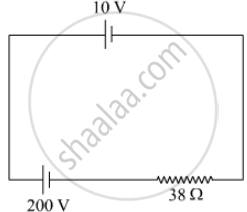
Chapter: [0.03] Current Electricity
In a potentiometer arrangement for determining the emf of a cell, the balance point of the cell in open circuit is 350 cm. When a resistance of 9 Ω is used in the external circuit of the cell, the balance point shifts to 300 cm. Determine the internal resistance of the cell.
Chapter: [0.03] Current Electricity
Advertisements
An iron ring of relative permeability µr has windings of insulated copper wire of n turns per meter. When the current in the windings is I, find the expression for the magnetic field in the ring.
Chapter: [0.04] Moving Charges and Magnetism
The susceptibility of a magnetic material is 0·9853. Identify the type of magnetic material. Draw the modification of the field pattern on keeping a piece of this material in a uniform magnetic field.
Chapter: [0.05] Magnetism and Matter
A bar magnet of magnetic moment 6 J/T is aligned at 60° with a uniform external magnetic field of 0·44 T Calculate
a) the work done in turning the magnet to align its magnetic moment
i) normal to the magnetic field,
ii) opposite to the magnetic field, and
b) the torque on the magnet in the final orientation in case (ii).
Chapter: [0.04] Moving Charges and Magnetism
Define the term 'conductivity' of a metallic wire. Write its SI unit.
Chapter: [0.03] Current Electricity
Using the concept of free electrons in a conductor, derive the expression for the conductivity of a wire in terms of number density and relaxation time. Hence obtain the relation between current density and the applied electric field E.
Chapter: [0.03] Current Electricity
Four point charges Q, q, Q and q are placed at the corners of a square of side 'a' as shown in the figure.
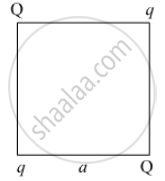
Find the
1) resultant electric force on a charge Q, and
2) potential energy of this system.
Chapter: [0.02] Electrostatic Potential and Capacitance
Three-point charges q, – 4q and 2q are placed at the vertices of an equilateral triangle ABC of side 'l' as shown in the figure. Obtain the expression for the magnitude of the resultant electric force acting on the charge q

(b) Find out the amount of the work done to separate the charges at infinite distance.
Chapter: [0.01] Electric Charges and Fields
Find out the amount of the work done to separate the charges at infinite distance.
Chapter: [0.02] Electrostatic Potential and Capacitance
A symmetric biconvex lens of the radius of curvature R and made of glass of refractive index 1.5, is placed on a layer of liquid placed on top of a plane mirror as shown in the figure. An optical needle with its tip on the principal axis of the lens is moved along the axis until its real, inverted image coincides with the needle itself. The distance of the needle from the lens is measured to be x. On removing the liquid layer and repeating the experiment, the distance is found to be y. Obtain the expression for the refractive index of the liquid in terms of x and y
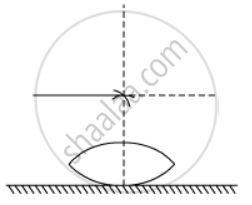
Chapter:
Show using a proper diagram how unpolarised light can be linearly polarised by reflection from a transparent glass surface.
Chapter: [0.1] Wave Optics
The figure shows a ray of light falling normally on the face AB of an equilateral glass prism having refractive index`3/2`, placed in water of refractive index `4/3`.Will this ray suffer total internal reflection on striking the face AC? Justify your answer.
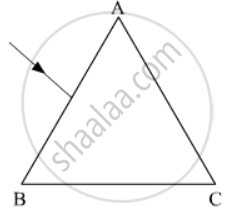
Chapter: [0.09] Ray Optics and Optical Instruments
State Bohr's postulate to define stable orbits in the hydrogen atom. How does de Broglie's hypothesis explain the stability of these orbits?
Chapter: [0.12] Atoms
A hydrogen atom initially in the ground level absorbs a photon, which excites it to the n = 4 level. Determine the wavelength and frequency of the photon.
Chapter: [0.12] Atoms
If one of two identical slits producing interference in Young’s experiment is covered with glass, so that the light intensity passing through it is reduced to 50%, find the ratio of the maximum and minimum intensity of the fringe in the interference pattern.
Chapter: [0.1] Wave Optics
What kind of fringes do you expect to observe if white light is used instead of monochromatic light?
Chapter: [0.1] Wave Optics
Draw a typical input and output characteristics of an n-p-n transistor in CE configuration. Show how these characteristics can be used to determine (a) the input resistance (r1), and (b) current amplification factor (β)
Chapter: [0.14] Semiconductor Electronics - Materials, Devices and Simple Circuits
Give three reasons why modulation of a message signal is necessary for long-distance transmission
Chapter: [0.15] Communication Systems
Show graphically an audio signal, a carrier wave and an amplitude modulated wave
Chapter: [0.15] Communication Systems
Advertisements
Explain the processes of nuclear fission and nuclear fusion by using the plot of binding energy per nucleon (BE/A) versus the mass number A
Chapter: [0.13] Nuclei
A radioactive isotope has a half-life of T years. How long will it take the activity to reduce to a) 3.125%, b) 1% of its original value?
Chapter: [0.13] Nuclei
A student wants to use two p-n junction diodes to convert alternating current into direct current. Draw the labelled circuit diagram she would use and explain how it works.
Chapter: [0.14] Semiconductor Electronics - Materials, Devices and Simple Circuits
Give the truth table and circuit symbol for NAND gate
Chapter: [0.14] Semiconductor Electronics - Materials, Devices and Simple Circuits
The teachers of Geeta’s school took the students on a study trip to a power generating station, located nearly 200 km away from the city. The teacher explained that electrical energy is transmitted over such a long distance to their city, in the form of alternating current (ac) raised to a high voltage. At the receiving end in the city, the voltage is reduced to operate the devices. As a result, the power loss is reduced. Geeta listened to the teacher and asked questions about how the ac is converted to a higher or lower voltage.
1) Name the device used to change the alternating voltage to a higher or lower value. State one cause for power dissipation in this device.
2) Explain with an example, how power loss is reduced if the energy is transmitted over long distances as an alternating current rather than a direct current.
3) Write two values each shown by the teachers and Geeta.
Chapter: [0.07] Alternating Current
Draw a ray diagram to show image formation when the concave mirror produces a real, inverted and magnified image of the object.
Chapter: [0.09] Ray Optics and Optical Instruments
Obtain the mirror formula and write the expression for the linear magnification.
Chapter: [0.09] Ray Optics and Optical Instruments
Write two important advantages of reflecting telescope over a refracting telescope.
Chapter: [0.09] Ray Optics and Optical Instruments
Using Huygens’ principle, verify the laws of reflection at a plane surface.
Chapter: [0.1] Wave Optics
In a single slit diffraction experiment, the width of the slit is made double the original width. How does this affect the size and intensity of the central diffraction band?
Chapter: [0.1] Wave Optics
When a tiny circular obstacle is placed in the path of light from a distant source, a bright spot is seen at the centre of the shadow of the obstacle. Explain why?
Chapter: [0.1] Wave Optics
Define electric flux.
Chapter: [0.01] Electric Charges and Fields
A point charge q is at a distance of d/2 directly above the centre of a square of side d, as shown the figure. Use Gauss' law to obtain the expression for the electric flux through the square.
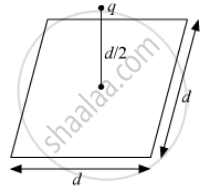
Chapter: [0.01] Electric Charges and Fields
If the point charge is now moved to a distance 'd' from the centre of the square and the side of the square is doubled, explain how the electric flux will be affected.
Chapter: [0.01] Electric Charges and Fields
Use Gauss' law to derive the expression for the electric field `(vecE)` due to a straight uniformly charged infinite line of charge density λ C/m.
Chapter: [0.01] Electric Charges and Fields
Draw a graph to show the variation of E with perpendicular distance r from the line of charge.
Chapter: [0.01] Electric Charges and Fields
Find the work done in bringing a charge q from perpendicular distance r1 to r2 (r2 > r1)
Chapter: [0.01] Electric Charges and Fields
State the principle of an ac generator and explain its working with the help of a labelled diagram. Obtain the expression for the emf induced in a coil. having N turns each of cross-sectional area A, rotating with a constant angular speed 'ω' in a magnetic field `vecB` directed perpendicular to the axis of rotation.
Chapter: [0.06] Electromagnetic Induction
An aeroplane is flying horizontally from west to east with a velocity of 900 km/hour. Calculate the potential difference developed between the ends of its wings having a span of 20 m. The horizontal component of the Earth's magnetic field is 5 × 10–4 T and the angle of dip is 30°.
Chapter: [0.06] Electromagnetic Induction
A device X is connected across an ac source of voltage V = V0 sin ωt. The current through X is given as
`I = I_0 sin (omega t + pi/2 )`
1) Identify the device X and write the expression for its reactance.
2) Draw graphs showing the variation of voltage and current with time over one cycle of ac, for X.
3) How does the reactance of the device X vary with the frequency of the ac? Show this variation graphically.
4) Draw the phasor diagram for the device X.
Chapter: [0.07] Alternating Current
Other Solutions
Submit Question Paper
Help us maintain new question papers on Shaalaa.com, so we can continue to help studentsonly jpg, png and pdf files
CBSE previous year question papers Class 12 Physics with solutions 2017 - 2018
Previous year Question paper for CBSE Class 12 Physics-2018 is solved by experts. Solved question papers gives you the chance to check yourself after your mock test.
By referring the question paper Solutions for Physics, you can scale your preparation level and work on your weak areas. It will also help the candidates in developing the time-management skills. Practice makes perfect, and there is no better way to practice than to attempt previous year question paper solutions of CBSE Class 12.
How CBSE Class 12 Question Paper solutions Help Students ?
• Question paper solutions for Physics will helps students to prepare for exam.
• Question paper with answer will boost students confidence in exam time and also give you an idea About the important questions and topics to be prepared for the board exam.
• For finding solution of question papers no need to refer so multiple sources like textbook or guides.
